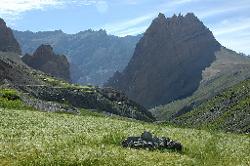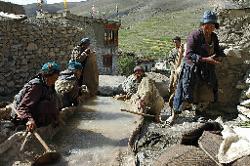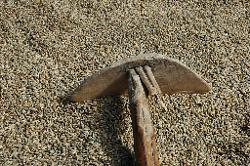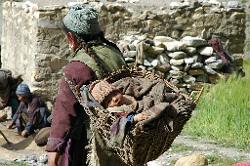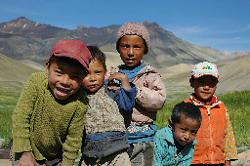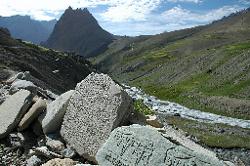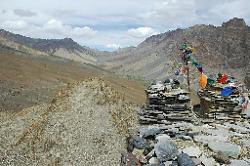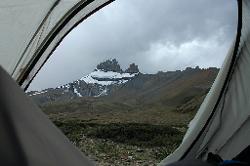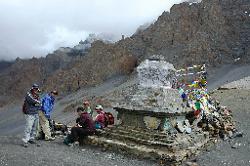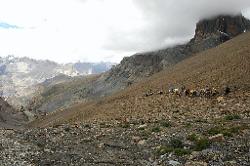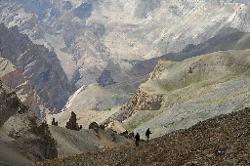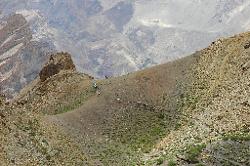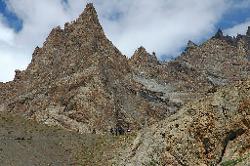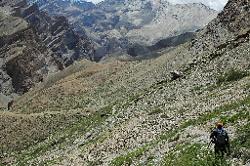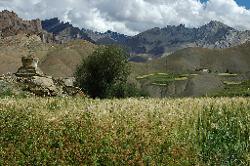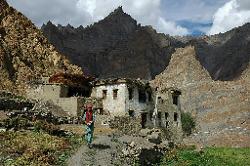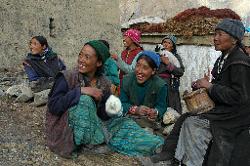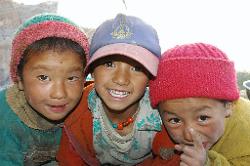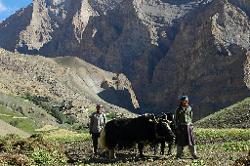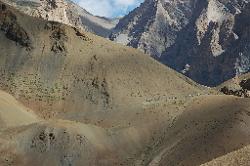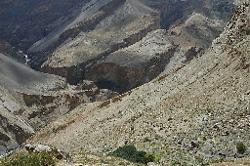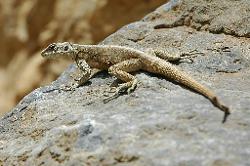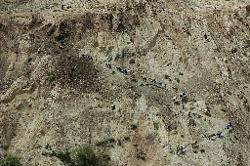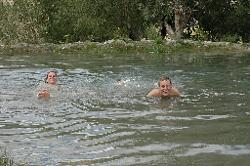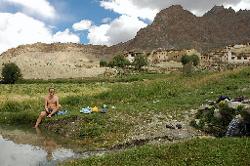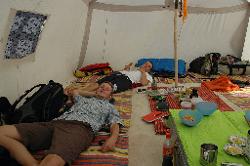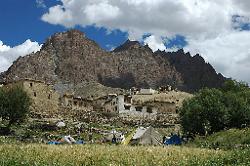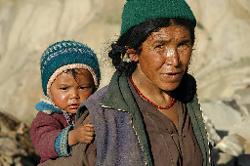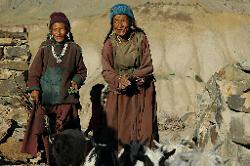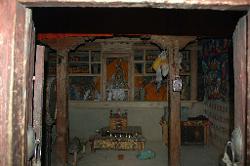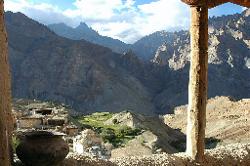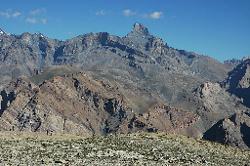MyHimalayasimpressions from |
|
|||||||
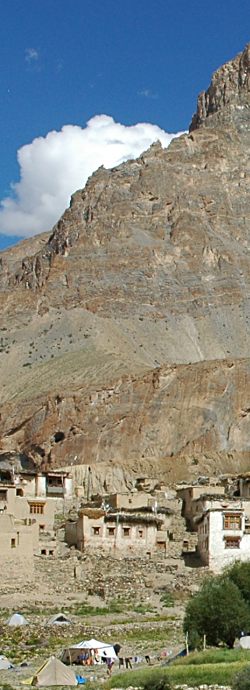
Ladakh to Zanskar: Photoskar to Nyerak
Photaskar - Bumiktse La - Senge La Camp (Day 8)
The village has quite a different appearance in the back light of the morning sun. The fields are of a light green, the gorges behind the houses just shady silhouettes in the slight morning haze. Smoke curls up from the flat roofs. Goats herds, each about a dozen animals, are being driven to pastures by women and young girls and boys. The animals are kept outside the village in high stone-walled compounds which we pass on the way to the settlement. What I took for dilapidated houses yesterday are in fact greenhouses with small vegetable gardens where mustard, salad and onions are grown.
The village seems deserted, but then we met half a dozen villagers working near the little rivulet that goes through the village. They are not washing gold are they? No, they are concerned with food for the winter. Bags full of barley corns are cleaned in the water, and spread out nearby to dry in the sun. Afterwards it is brought down to the mill where it is ground into tsampa, barley flour. Despite rice rations handed out to every village by the government, tsampa remains the staple diet in Ladakh. Since it cannot be used for baking bread, people mix the flour with salt tea and butter - the meal for almost every day in every year.
We cross the river and start our walk towards Singe La. From across the scenery is fantastic: to the left rise the high dark mountains, below us are the houses which stand atop of organ-pipes, and in between spread out the green fields which cover the entire valley up to steep reddish canyon walls at the very right.
Crossing some flat valleys, today's pass appears before us. Bumiktse La is just a short walk up a little ridge, and an easy trail leads up to it. Parts of the valley are wet and muddy, many yaks and goats graze in the green valley. Lots of marmots and pika can be seen and heard whistling to warn the others about the intruders.
A strange haze appeared on the blue sky in the early morning, indicating a weather change. Now that we've reached the pass all blue color is gone, and thick clouds appear on the overcast sky. Luckily from Bumiktse La we can see tomorrow's pass, the Singe La, with the large peak to the right of it, so camp can't be far away. We reach it by crossing a wide stream barefoot, and passing a dead, foul-smelling horse. The black clouds are full of rain, and you can literally see the downpour approaching us from all sides. It's just another small river-crossing and I'm at the campsite, put up my tent and wash in the river just before a heavy downpour. Rain stops after dinner and stars come out.
Senga La Camp - Singe La - Yulchung (Day 9)
Hard rain on the tent wakes me during the night. The morning looks a little brighter, although Singge La is hidden in low-hanging clouds, good weather is moving in from the north. Any hope that the weather from the north will win is dashed ten minutes after starting our walk. Hard rain sets in. I'm happy to have packed the good (and expensive) rain-gear which - thanks to the umbrella - barely gets wet. At first it's a gentle climb up the wide valley, through a patchwork of low juniper bushes. Marmots come out of their holes and watch us pass them. The face of the pass looms as black scree slope against dark clouds. The last bit goes steeply up, I take the short-cut for the first part but switch to the regular, less steep trail. I'm not in as good a shape as I should be. Maybe my expectations are too high, Singe La is around 5'000 m high (some say 4'900 m, others 5'050 m) and therefore feeling tired is actually natural.
Before enjoying the views on top of Sengge La, the cold wind forces me to put on more clothes. The pass seems to separate the weather, while in the north where we came from it's still very cloudy, the southern side features blue sky with some wandering clouds. Far down in the valley green fields stand out from the rugged landscape and the sheer cliffs of Zanskar. It's an intimidating and curious sight. In the next days we will wander in and finally up those gorges and to the hidden passes that take us into the heart of Zanskar.
But first we must reach today's campsite at Yulchung - a village (or actually "small country" if translated correctly) that doesn't see many trekkers despite its proximity to Lingshed. We descend on a scree slope with several kinds of small flowers. To our left rise orange cliffs, to our right black rock faces covered by snow.
Passing the little creek where people usually camp on their way up, we're on a very small path that follows high above the river and have lunch further down. Rain and wind have formed bizarre figures in the rock and even left mansized holes in the sheer walls. Some of caves are used by people, a large one serves as a meditation cave for lamas. Very narrow side valleys drain the massif into the creek that flows in the Zanskar river some hours further down.
It's no use hurrying since the trail is partially destroyed further down. The horseman are repairing it before we can proceed. Even after the fix, it's hard to imagine how they got the horses to cross the difficult parts. The slope drops steeply, and the stone plates which they used to fix the trail do not look too stable. Anyway, the caravan is ahead of us now; the silhouettes of horses against the backdrop of the Zanskar range looks fantastic.
Nothing indicates human presence except the trail that descends down the rock-strewn and hot gorge.
After a bend suddenly the barley fields and houses of Yulchung appear. More fields and houses are built in the amphitheatric valley. What an oasis at 4'000 meters. The "small land" is a jewel. Both its scenery and the people are outstanding. The villagers are very friendly, the few kids who are not off to school in Lingshed are shy and reserved at first. The local health worker who opens the monastery to show me around is knowledgeable and speaks good English. He tells me that the village had its own king before, however the former palace is in ruins now because the royal family broke up. Some moved to Nyerak, the village across the Zanskar, some moved to other places.
Today 70 people live in the 10 houses that constitute Yulchung. The gompa was partially renovated and is administered by Lingshed gompa. On special occasions a monk or lama is sent for to conduct ceremonies. Old thangkas and a three-dimensional mandala are the most noticeable artifacts, apart from several statues which have mostly been brought from Tibet and look quite old.
The setting sun turns the valley into a basket of yellow and green, with white houses standing out and a majestic, rugged cliffs forming the boundaries. It's a great evening scene, the vastness of the landscape is increased by the puffy clouds in the clear sky.
Yulchung - Nyerak (Day 10)
Orange clouds float in the light blue sky in the early morning, then the cliffs turn from silhouettes to structured and intricate system of canyons and colors, finally the gentle hillsides catch the soft light.
I leave late and pass a family working the field with two yaks and a wooden plough. The yaks are not too disobedient, and only an occasional sharp yell is necessary to keep them moving and steer them. Reddish-color Ladakhi tea and tsampa stand next to the field. The daughter invites us for breakfast but we decline. I'm surprised how many young people return from places like Jammu during summer holiday. These days it is common for children to leave the village for education, and most of those I talk to want to return to their village once they finish their studies. But they can't imagine working as farmers and would like come back and work as teachers, doctors or engineers. Since it is unlikely that a large "service industry" will spring up in those villages, I question whether they can really return. What will happen to the villages then? Will the decrease of population lead to mono-culture where only city-life is admired? Is this loss of diversity just something I personally feel sad about, or does it negatively impact the lives of Ladakhis? In Switzerland the same thing has happened and is happening - remote villages are overaged and disappear, and with it the culture that have persisted for so long. It never concerned me much at home, so maybe I'm a hypocrite who just needs foreign culture to spice up my holidays.
A small monastery, or rather gompa ("isolated place"), stands high above the gorge at the southern ridge. One minute after passing the chorten that marks the village's exit, all houses are out of sight and we seem to be in the middle of nowhere again. A narrow trail traverses the slope which is to steep to see the river below us. Narrow canyons lead away from us, only shades make the little valleys visible. A repeated cry - of a young eagle in its nest? - echoes through the gorge. We drop into a side valley on whose grassy plains yaks and mules are grazing. Then we climb up the Chocho Guru la, "pass of the brother with bended back". The views down into the valley system of Zanskar are breathtaking: gorges that look like deep cuts in the stone appear surreal, as if somebody had first broken the land by hand and sliced it with a knife. Across us lie the light green fields of Nyerak where a dozen houses stand at the edges of green fields. Getting there won't be easy, a long way down and up again in the hot sun wait for us.
A steep descent brings us to the Zanskar river whose brown waters eat away at the narrow gorge that confines it. The horses are just crossing the rickety bridge that spans the river at a narrow spot, with the river ten meters below. All of the animals and crew cross safely. In winter, the frozen river is much, much lower and the Chadar route the only way from Ladakh to Zanskar. We rest some minutes near the bridge, and push on.
A zig zag trail goes up to the village. After passing a strange looking lhatso, built from blue sheep horn, we stop at a large white chorten for lunch. The little shade offers a welcome break from the fierce sun that has been burning down relentlessly since early morning. A last climb before camp. My legs feel fine, I'm in good shape now, but the sun makes it hard to walk, heart beating, sweat flowing. After climbing the barren slope with lizards as the only diversion from the heat, finally the first field appears. While the golden ears are gently moving in the wind the steep canyon walls behind them display not any sign of life.
Several small trails lead to the distributed village. Women working in the fields point out the right trail. It is still hot, and each occasional breeze is a relief. I pass a very tempting pool on the way up, wondering whether I'll have enough motivation to visit it after settling down at camp. Luckily no test of will is necessary, five minutes later I reach the campsite and find a similar pool nearby. It looks deceptive, the water temperature are freezing, but not cold enough to decrease my initial eagerness: I enjoy a quick swim, and then lie on the grass to dry in the hot sun. Half an hour later it's so hot that I consider a second plunge, but finally laziness wins and I take a siesta.
Afterwards I take stroll through the widespread fields where women and children are harvesting peas. I stay at a group of chortens from where the views of Chocho Gurmu La and Singe La, our route over the last two days, are splendid. The cliffs seem to change color and shape every time a cloud moves over the sun. Rose hip bushes separate the fields, some parts are used to grow tall grass and flowers, others are used for barley or peas. The panoramic view from further away is stunning. above the green pea fields and yellow barley fields rise the rock faces, the village's whitewashed houses have a fort-like appearance and the monastery stands above the village. Clouds, white, grey and black, gather above the red cliff that leads to tomorrow's pass. Sand-dunes with bushes and conifers grow in the gullies between the washed-out hillsides. Chortens are built very high up, probably all the way to the 5'000 Takti La though the pass itself isn't visible from here. Despite the many different and conflicting aspects, the landscape is very harmonious.
A walk through the village reveals that the dozen large houses are connected to each other, in a intricate maze of courtyards and roofs. Mani walls (or better mani piles) are numerous, and many of the inscribed stones look quite recently made. An impressive pile of those stones lie above the monastery that overlooks the village. The altar room is simple and features a statue of Chenrezig and a three-dimensional mandala. It's the second mandala I see here (after Yulchung), and since I haven't seen many others in the Himalayas (except in Potala in Lhasa), they might be a special local custom. Like in Yulchung, no permanent monk resides in the village itself. From the courtyard the views over the valley are nice, especially in the evening light.
It was another great day and we crossed from Ladakh into Zanskar.
|
Summary Part 3:
On the way to the lion's pass, Singe La, the weather turns foul
but luckily changes as soon as we reach the top. We look down
into the Zanskar valley where the river has eaten its way into
the rock and formed a deep valley. The landscape becomes more
rugged, making the cultivated fields stand out from the ochre
hills. On a narrow trail we reach Yulchung, an idyllic valley
where the fields are grouped like seats of an amphitheater. The
next day we cross the Zanskar river and climb up to Nyerak. From
our tents below willow trees we look back to the passes we have
crossed in the last two days. |
